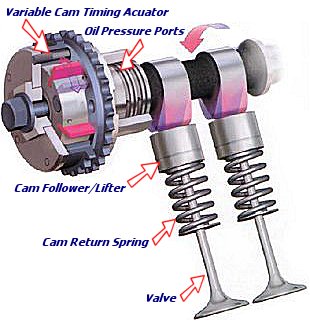The process of altering the timing of a valve lift event, often used to improve performance, fuel economy or emissions is called as variable valve timing (VVT),used in internal combustion engines.
Ensure that optimum power is delivered throughout the power-band of a
vehicleVVT systems enhances the fuel efficiency of a vehicle. It eliminates the problem of low-power lag or top-end punch lag
in conventional IC engines. The cam-phasing units retard or advance the
valve closing or opening time to gain performance and fuel efficiency,is the most common method of Variable Valve
Timing application.
The start-stop system turns off the engine of a vehicle when it is at
halt and restarts it once the driver re-engages the gas pedal. It helps
improving the fuel economy and performance of the vehicle; also helps
reduce the exhaust emission levels
 (Source-Google images)
(Source-Google images)
The simplest, cheapest and most commonly used
mechanism at this moment is CAM-PHASING VVT. However, its performance gain is also the least, very
fair indeed.
It varies the valve timing by shifting the phase angle of camshafts. For
example, at high speed, the inlet camshaft will be rotated in advance by 30° so
to enable earlier intake. This movement is controlled by engine management
system according to need, and actuated by hydraulic valve gears.

Note that cam-phasing VVT cannot vary the duration
of valve opening. It just allows earlier or later valve opening. Earlier open
results in earlier close, of course. It also cannot vary the valve lift, unlike
cam-changing VVT. However, cam-phasing VVT is the simplest and cheapest form of
VVT because each camshaft needs only one hydraulic phasing actuator, unlike
other systems that employ individual mechanism for every cylinder.
Continuous
or Discrete
Simpler
cam-phasing VVT has just 2 or 3 fixed shift angle settings to choose from, such
as either 0° or 30°. Better system has continuous variable shifting, say, any arbitary value between 0° and 30°, depends on rpm.
Obviously this provide the most suitable valve timing at any speed, thus
greatly enhance engine flexiblility. Moreover, the transition
is so smooth that hardly noticeable.
Intake
and Exhaust
Some
design, such as BMW's Double Vanos system, has
cam-phasing VVT at both intake and exhaust camshafts, this enable more
overlapping, hence higher efficiency. This explain why BMW M3 3.2 (100hp/litre)
is more efficient than its predecessor, M3 3.0 (95hp/litre) whose VVT is
bounded at the inlet valves.
In the
E46 3-series, the Double Vanos shift the intake
camshaft within a maximum range of 40° .The exhaust camshaft is 25°.


The key manufacturers of VVT systems have been
identified as Denso Corp. (Japan), Schaeffler AG (Germany), Hilite
International (Germany), and Hitachi Automotive (Japan). In Start-Stop
systems market the key players are Robert Bosch GmbH (Germany), Denso
Corp. (Japan), Delphi Automotive plc (U.S.), and Remy International
(U.S.). These companies collectively account for a major share of their
respective markets. However, the demand for both these technologies is
highly dependent on the automobile industry and hence is the case with
automobile industry. The market for Variable Valve Timing and start-stop
systems is expected to grow at a healthy pace over the next five years.
Variable Valve Timing & Start-Stop Systems: Market Revenue, By Products, 2011 – 2018 ($Million)

(Source: MarketsandMarkets Analysis)
For more info,visit-
http://www.marketsandmarkets.com/Market-Reports/variable-valve-timing-vvt-market-1206.html
No comments:
Post a Comment